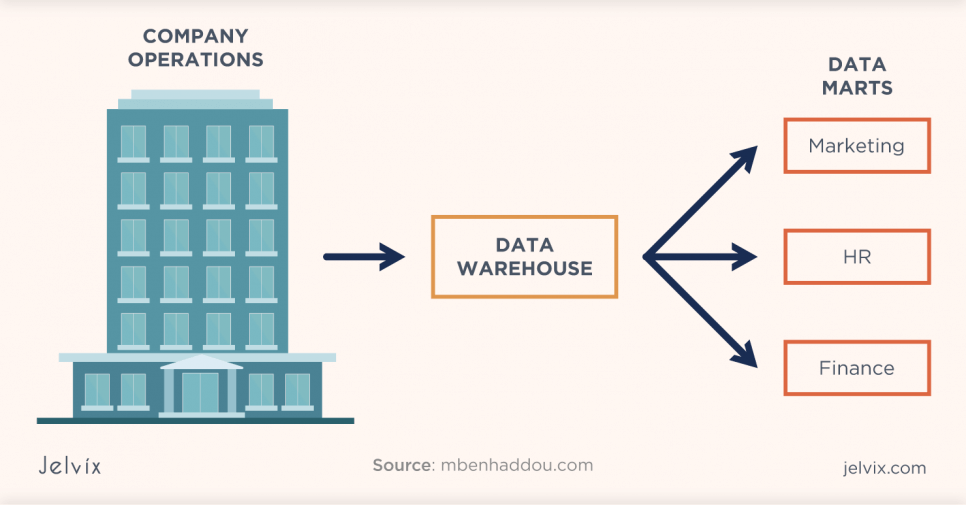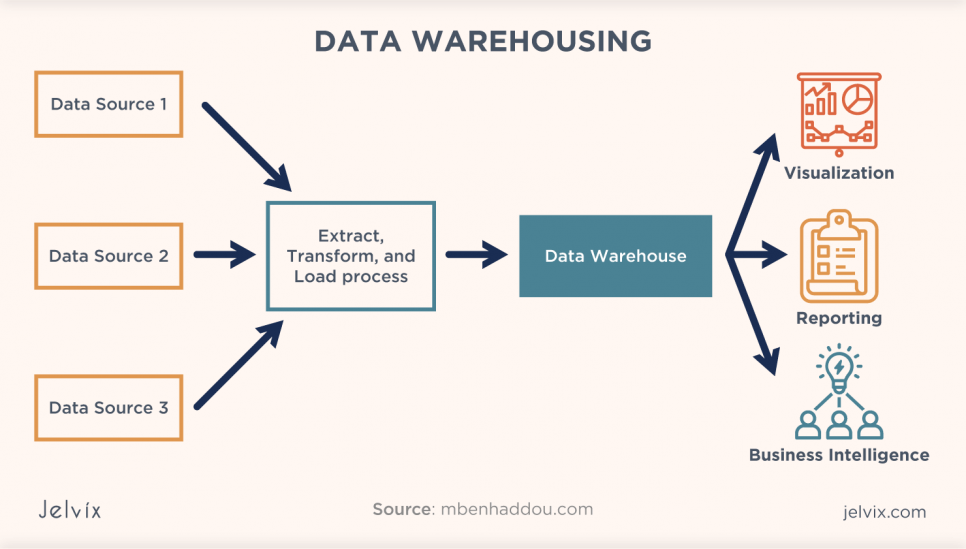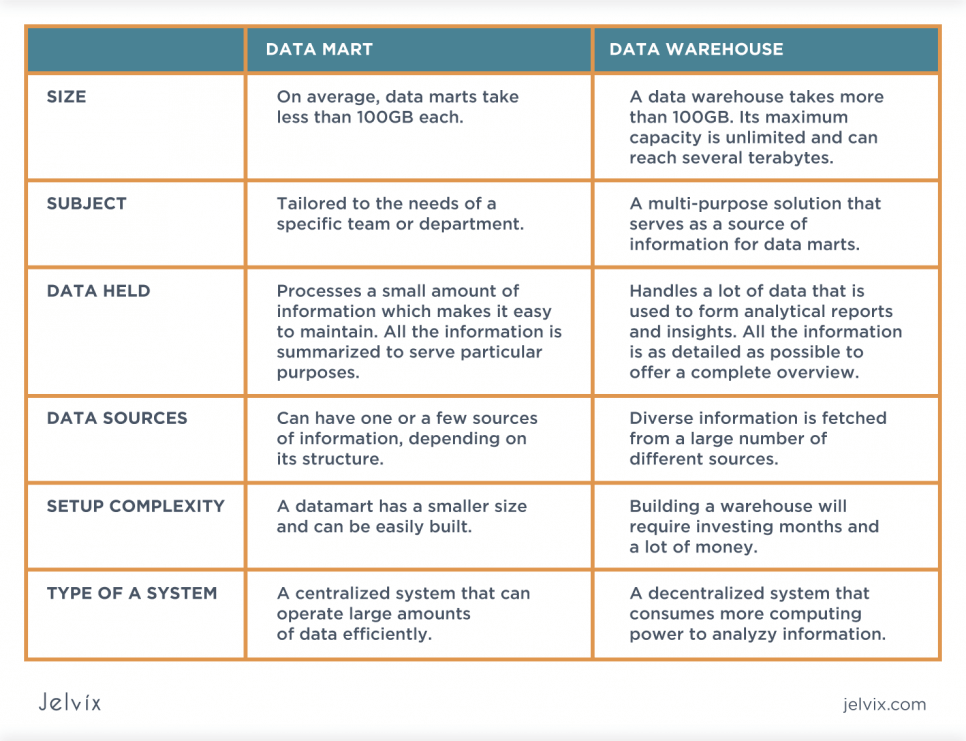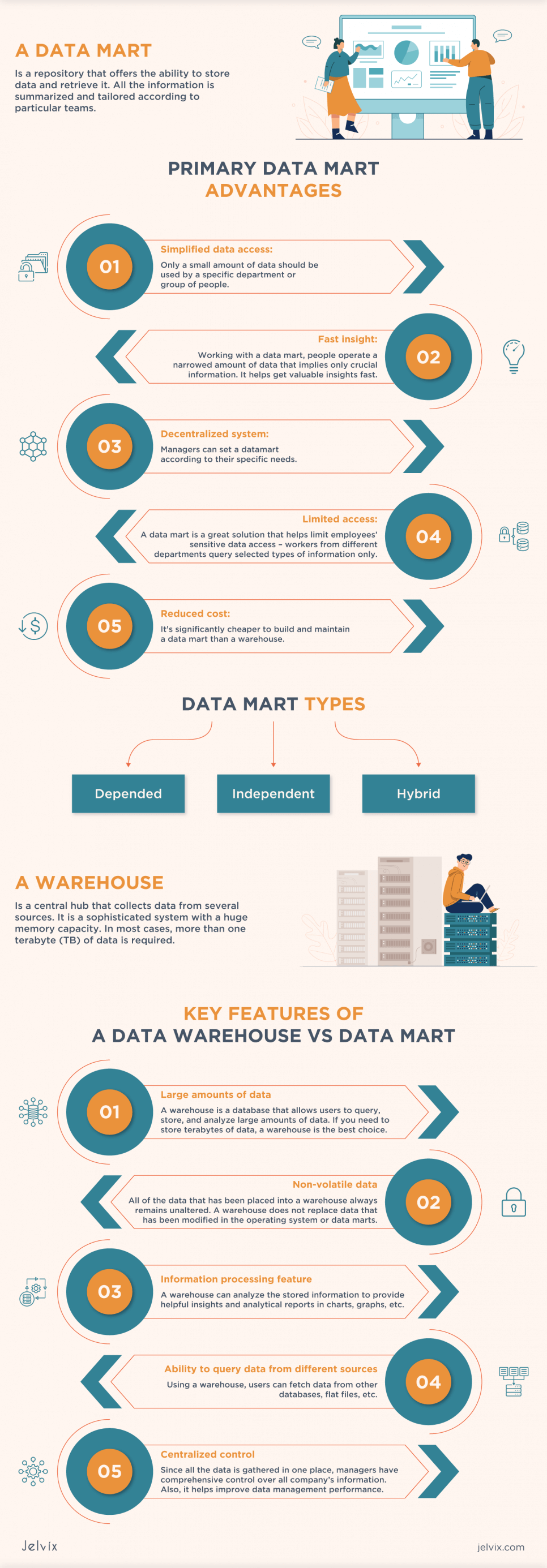Nowadays, we’re living in the era of Big Data. It’s difficult to operate a business without accumulating and analyzing vast amounts of information. As a result, our lives are increasingly reliant on data storage and processing.
According to the research conducted by The Conversation, there are more than 59 zettabytes of data created, shared, and stored worldwide. One zettabyte (ZB) equals a trillion gigabytes. Yet, the experts expect the amount of data to increase three times by 2025. And all this information has to be stored and analyzed to get helpful insights.
In this post, we’ll take a deep dive into the realm of information. You will define data mart, discover how it operates, and learn more about its essential characteristics in the post below. You’ll also learn why a data mart isn’t the same thing as a warehouse.
What Is a Data Mart?
Understanding the data mart concept does not require a high level of technical knowledge. According to a popular data mart definition, it’s a repository that offers the ability to store data and retrieve it. All the information is summarized and tailored according to particular teams.
A corporation might have a variety of data marts. All of them are unique solutions that meet the demands of certain people – employees or customers. Despite this, all data marts are part of a large warehouse that stores all the data. Only a few sources of information are used in a data mart. In most cases, the only source of information for a data mart is a warehouse.
The basic goal of a data mart is to provide certain teams with only the information they need. For example, a warehouse may have a table that implies hundreds of rows containing helpful information on a bank’s customer. Yet, to address all situations, the support department should only have access to a dozen rows. Therefore, a data mart provides access to a certain sort of data retrieved from a warehouse.
It’s a concise explanation that helps answer the question, “What is data mart, and what is its purpose?” It is a required solution for most companies. Indeed, it helps simplify a lot of processes related to data management. Yet, they also have a lot of advantages.
Primary Data Mart Advantages
- Simplified data access: Only a small amount of data should be used by a specific department or group of people.
- Fast insight: Working with a data mart, people operate a narrowed amount of data that implies only crucial information. It helps get valuable insights fast.
- Decentralized system: Managers can set a datamart according to their specific needs.
- Limited access: A data mart is a great solution that helps limit employees’ sensitive data access – workers from different departments query selected types of information only.
- Reduced cost: It’s significantly cheaper to build and maintain a data mart than a warehouse.
Reasons To Create a Data Mart
In mere words, a data mart is an environment that gathers detailed data from a warehouse. Also, it delivers them in a particular way.
Why do people need to hassle creating complicated data marts? Can all employees simply request the required information from a warehouse? Let’s review the primary reasons to create data marts to find answers to these questions.
For starters, it enhances the user experience by providing access to the frequently used data only. Besides, it helps reduce the load on the database, so all the requests get processed faster. As a result, it helps reduce the response time and increases performance.
Companies can spend fewer resources, whether their warehouse is installed on a cloud or on-premises. This is because a datamart can store information from different sources. Thus, it erases the need to request and gather it manually. Besides, it helps limit users’ access to the warehouse, which is crucial for most companies.
The key motivations for creating a data mart are to reduce response time and improve performance. Furthermore, establishing a separate warehouse is a costly and time-consuming operation. As a result, constructing a data mart is the only cost-effective alternative.
Data Mart Types
There are three basic types of data marts – Dependent, Independent, and Hybrid. The only distinguishing element that separates them is their relationship to the warehouse.
Depended
The most common type is dependent data marts. They’re linked to a warehouse to get data from it. This method facilitates the creation of a centralized and simple-to-manage system. Data marts don’t interface with a variety of data sources. Instead, a centralized database is used to query all of the data.
This method is known as top-down. Users must first establish a warehouse that contains all of the data. Then, it standardizes and organizes the data to make it easier to handle. The dependent type is the greatest option for large companies. It helps monitor all data meticulously and lowers data management expenses.
Independent
It’s a data mart that isn’t linked to a warehouse in any way. It’s a decentralized structure that’s ideal for smaller businesses. All of the data is queried from other sources. It’s the most notable feature of this data mart type. Down-top is the strategy employed by independent data marts.
Because a huge warehouse is not required, it considerably reduces construction costs. Even so, there are certain disadvantages. The data fed into data marts is not standardized. Therefore, ETL (Extract, Transform, Load) tools must do a lot of work. It’s also difficult to keep track of all the data fetched and analyzed because the system is decentralized.
Hybrid
It is a mixed type of data mart. Indeed, hybrid data marts can gather information from a centralized database. Yet, they also can supplement it with data from external sources. It is a solution that is widely used when users need to create custom solutions. A hybrid type can gather information from several warehouses and other data marts. All the data is formed in a particular array of details needed to run a business effectively.
Structure of a Data Mart
The relation type is present in all data marts. In a nutshell, the information in tables is organized into columns and rows. All of them are connected with each other in a particular way. It’s the most common strategy, and it’s what most databases use. Nevertheless, data marts utilize two separate schemas to organize all of the information.
Star Shema
The Star Schema means that there is just one primary table that queries data from many dimension tables. The structure resembles a star. This is because the dimensions are unrelated to one another. Instead, they’re data sources for the main table. This structure is great for the quick and effective administration of data. As a logical consequence, it is commonly used in large corporations.
Snowflake
Displayed on a blueprint, this structure looks like a snowflake. In a nutshell, it is a tweaked Star Schema. Dimension tables have extra tables to extend the amount of data. It is a smart trick that helps save disk space. However, the star schema has a low performance. Unfortunately, a lot of computing power is required to gather all the information from dimension tables.
What Is a Warehouse?
It’s impossible to answer the question, “What is the difference between a data mart and a data warehouse?” without taking a deep dive into the way data is stored. To do so, let’s discover what a warehouse is in a nutshell.
A warehouse is a central hub that collects data from several sources. It is a sophisticated system with a huge memory capacity. In most cases, more than one terabyte (TB) of data is required. The cost of constructing warehouses is high. As a result, they are mostly employed by major corporations. They allow gathering all of the data in one place and gaining valuable insights.
Because a warehouse is a centralized storage facility, all data must be standardized. Data is converted and recorded when it is queried from various sources. Thus, it makes data administration easier. Having all the data in one location makes it easier to make critical decisions. They are based on a thorough understanding of comprehensive analysis.
A warehouse has several disadvantages. For starters, it’s hard to build and maintain a warehouse. To create one, developers need to spend up to one year, on average. It results in a high price for a warehouse building. Secondly, there is a big chance of failure because a lot of data from different sources is processed. Nevertheless, a warehouse has a lot of unique advantages.
Let's find out how the Enterprise Data Warehouse can help solve big data challenges.
Key Features of a Data Warehouse vs Data Mart
- Large amounts of data. A warehouse is a database that allows users to query, store, and analyze large amounts of data. If you need to store terabytes of data, a warehouse is the best choice.
- Non-volatile data. All of the data that has been placed into a warehouse always remains unaltered. A warehouse does not replace data that has been modified in the operating system or data marts.
- Information processing feature. A warehouse can analyze the stored information to provide helpful insights and analytical reports in charts, graphs, etc.
- Ability to query data from different sources. Using a warehouse, users can fetch data from other databases, flat files, etc.
- Centralized control. Since all the data is gathered in one place, managers have comprehensive control over all company’s information. Also, it helps improve data management performance.
Is an Operational Database Similar To a Warehouse?
A warehouse is essentially a big database that holds all the information needed to manage business sources. A data mart allows different departments like sales, customer service, and marketing to query data from a single source. Yet, a warehouse is not the same as a standard operational database because of several unique characteristics.
For instance, a warehouse can handle massive volumes of data quickly, which is a prerequisite for major businesses. A typical operational database is used to request a few values in response to demand. A warehouse provides access to terabytes of organized and standardized data. As a result, warehouse inquiries are usually complex and need a large amount of data processing.
Traditional databases offer the ability to overwrite data in tables or drop it. However, a warehouse provides read-only permission. Users or systems can request data but are not allowed to modify it. It helps track the changes of all the records in a warehouse.
An operational database can rapidly insert and extract a lot of records. Therefore, such databases are widely used for managing transactions. On the other hand, warehouses are designed to analyze large amounts of data and provide insights.
Data Mart vs Data Warehouse
When the questions, “What is the meaning of a data mart?” and “What is a warehouse?” are answered, it’s about time to dive a little deeper. So let’s start by outlining the primary qualities that distinguish a data warehouse from a data mart, as shown in the comparison table below.
Data Mart Example of Use
Let’s look at some examples to understand the difference between data warehouse and data mart. The finest illustration of a data mart’s application is a tool for assisting the marketing department’s everyday tasks. To design and optimize marketing campaigns, managers need to have access to a vast amount of data.
They need to have access to the information on the number of clients attracted. Also, they have to be informed about the amount of money spent on their acquisition to analyze ROI (return on investment). A data mart can assist them in tracking their progress and quickly updating their marketing plans. They’ll also get data from a reliable source: a company’s warehouse.
They have access to all of the data they need for creating reports. Marketing managers, on the other hand, do not have access to other clients’ data. They don’t have access to clients’ identifying or billing information, for example. This use case helps answer the question, “What is a data mart with an example?”
Use Case of a Data Warehouse
A data warehouse may be used for a variety of purposes. The most popular is connected to big data analysis. For example, a warehouse can be used by a large corporation that is focused on providing stock market forecast predictions.
Using a warehouse, they can fetch a lot of different information from various sources and standardize it. Moreover, they can analyze all the data in real-time and deliver helpful insights simultaneously. In addition, a warehouse has great performance to process a lot of data fast. Thus, it can help bring a great advantage over competitors.
There is no need to wait hours or even days to get insights generated when using a warehouse. Also, it can keep all the statistical data unchanged to analyze it and find patterns that may help build predictive reports on the stock market.
Wrapping Up
Let’s highlight the main points of data marts vs data warehouse comparison. A warehouse and a data mart are two separate types of information storage and management systems used for various reasons. Each data mart is tailored to the requirements of a certain department or team.
A warehouse is a huge and expensive repository that stores all the information. However, it cannot be overwritten, so all the data remains secure. In addition, a warehouse has high performance that helps business owners get all the information analyzed rapidly. Consequently, they can get detailed reports lightning fast.
Large firms construct one warehouse and numerous data marts for various reasons. So, naturally, they’re all looking for information at the warehouse. Nevertheless, there are a few unique database systems that may be created. Our company can help you design a solution to tackle any challenge, thanks to Jelvix’s expertise in data science.
Do you have a question to ask? We can’t wait to help you. Feel free to get in touch to discuss your project with our manager. We always focus on building projects with high value and top-tier quality, regardless of the challenges needed to cope with.
Need a qualified team?
Use our top talent pool to get your business to the next level.


















